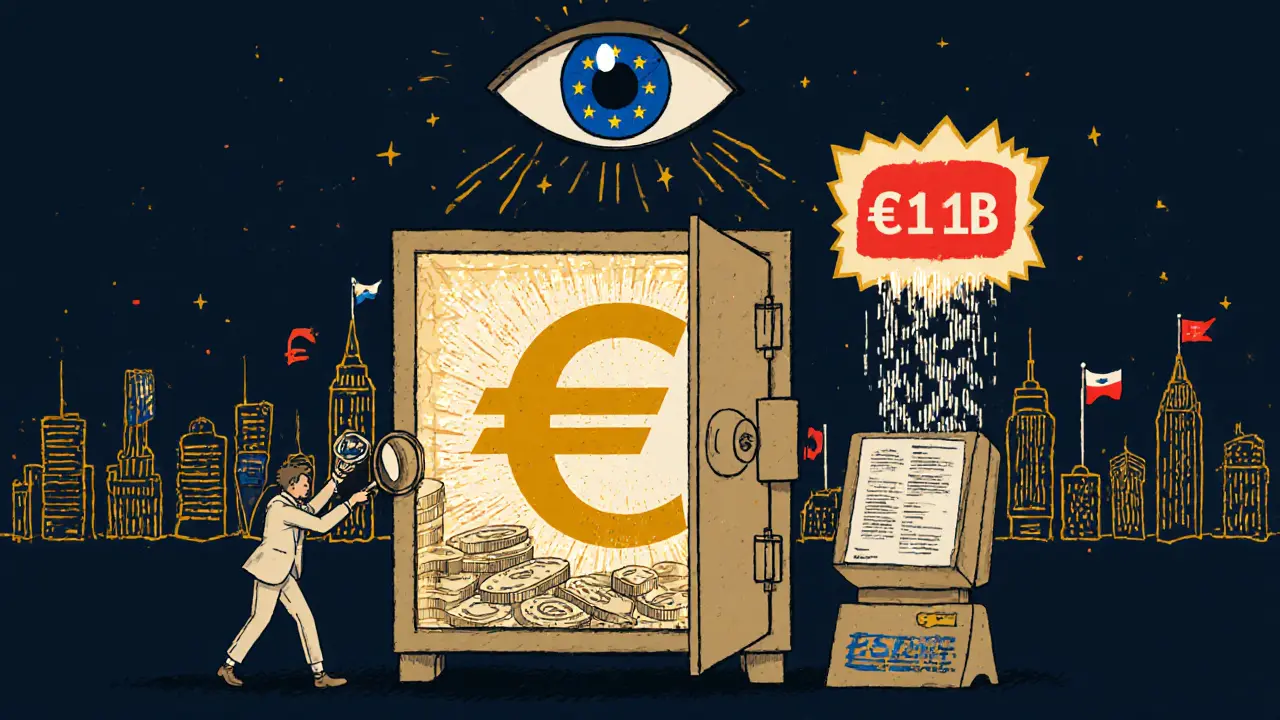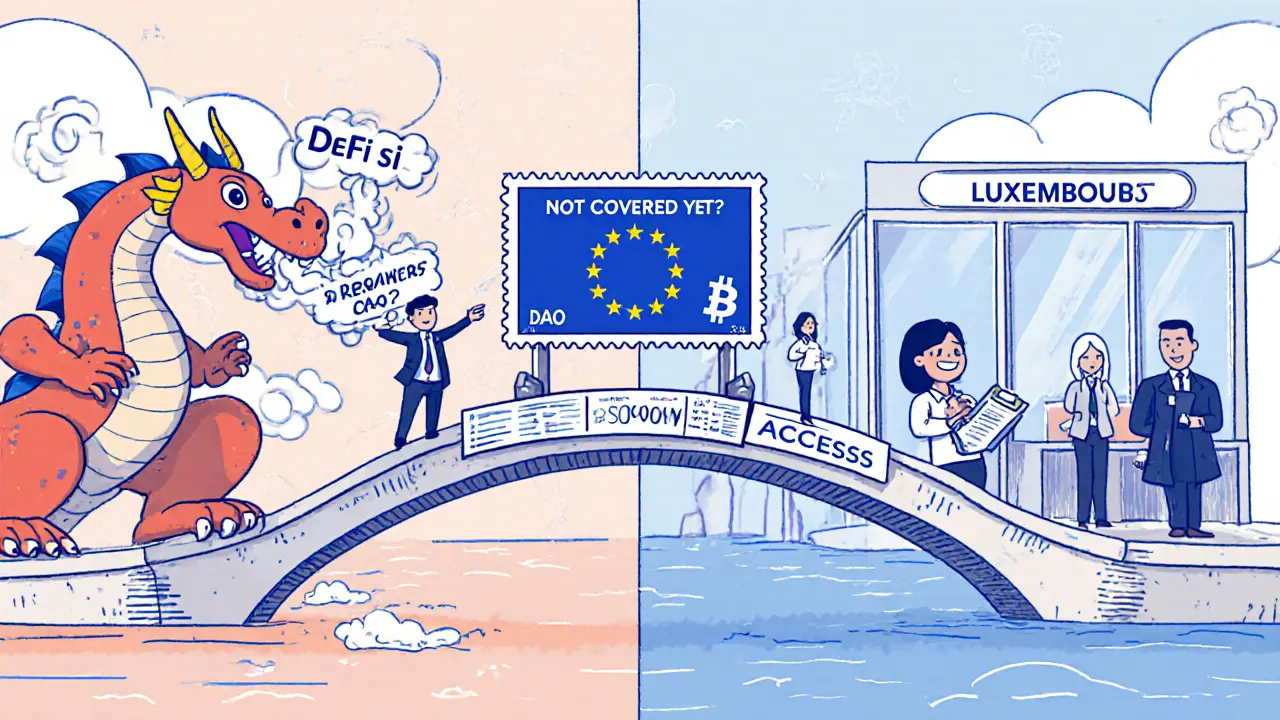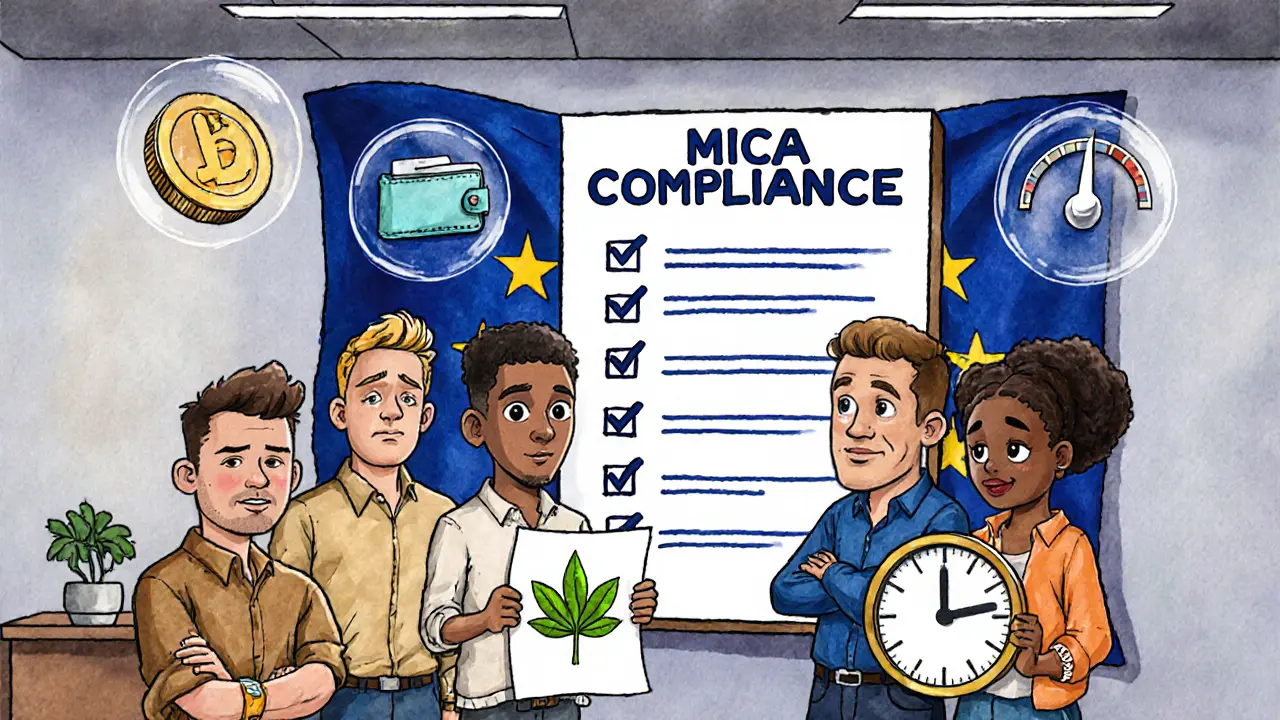MiCA Compliance Cost Calculator
Understand Your Compliance Costs
This tool estimates the minimum costs for MiCA compliance based on your business type and scale. Costs can vary significantly based on jurisdiction and specific business model.
Starting December 30, 2024, every crypto business serving customers in the European Union had to meet one of the strictest regulatory frameworks ever created for digital assets: the MiCA regulation. If you’re running a crypto exchange, issuing tokens, or offering wallet services to EU residents, this isn’t optional. It’s mandatory. And the clock didn’t stop ticking when the deadline passed - compliance is now a daily operation.
What Exactly Is MiCA?
MiCA stands for Markets in Crypto-Assets. It’s Regulation (EU) 2023/1114, passed by the European Parliament and enforced across all 27 EU member states. Before MiCA, crypto firms had to navigate 27 different sets of rules - one for each country. Now, if you’re authorized in France, you can operate in Germany, Spain, and Poland without reapplying. That’s the passporting system. But with that freedom comes heavy responsibility.MiCA doesn’t just cover exchanges. It applies to anyone offering crypto services professionally: custody, trading, issuance, staking, even tokenized asset platforms. If your business touches crypto and has EU users, MiCA likely applies to you.
Who Does MiCA Target?
MiCA breaks crypto businesses into two main buckets: Crypto-Asset Service Providers (CASPs) and token issuers.CASPs are companies whose core business is offering crypto services. That includes exchanges, wallet providers, brokers, and even some DeFi interfaces that act as intermediaries. To operate legally, you need authorization from a national regulator - like BaFin in Germany or AMF in France. You can’t just register online. You need a physical office in the EU, at least one director living in the same country as your license, and a minimum of €100,000 in capital. For order execution services, it’s €150,000.
Token issuers must publish a whitepaper approved by regulators. This isn’t a marketing brochure. It must include: technical specs, business model, risks, team background, and - critically - environmental impact. Yes, you have to disclose how much energy your blockchain uses. Even if you’re on Ethereum’s proof-of-stake, you still need to calculate and report emissions.
And then there are the significant CASPs (sCASPs). If your platform has more than 15 million average active users in the EU annually, you’re in a whole different league. You’ll face quarterly stress tests, direct oversight from ESMA (the European Securities and Markets Authority), and mandatory interoperability standards. That’s stricter than the U.S.’s proposed 100 million threshold for big platforms.
Stablecoins Are Under the Microscope
Stablecoins are the most tightly regulated part of MiCA. There are two types: asset-referenced tokens (like USDT or USDC) and e-money tokens (like EURC).If your stablecoin has a market cap over €1 billion, you’re subject to the toughest rules. You must hold 1:1 reserves in high-quality liquid assets - cash, short-term government bonds, nothing risky. And you must allow daily redemptions. No delays. No suspensions. No excuses.
For e-money tokens, reserves must be in euro-denominated deposits. No crypto collateral. No algorithmic tricks. Just plain cash. That’s why many stablecoin issuers are now setting up EU subsidiaries just to comply.
And here’s something no other major regulator requires: daily reserve verification. You can’t just audit once a quarter. You need automated systems that prove reserves match circulating supply every single day. This is why some stablecoins have pulled out of the EU entirely.
Compliance Costs Are Real - And High
Getting MiCA-compliant isn’t cheap. Most businesses spend between €500,000 and €1.2 million just to set up. That includes:- Legal and regulatory consulting: €150,000-€300,000
- AML/KYC software: €80,000-€200,000 per year
- Hiring an EU-resident director and a certified compliance officer (CAMS): €120,000+ salary
- Whitepaper development: €35,000 for simple tokens, up to €150,000 for complex stablecoins
- Office space: minimum 20m² per 5 employees, with local compliance requirements
And that’s just the start. Ongoing costs include quarterly stress tests for sCASPs, continuous environmental reporting, and keeping up with ESMA’s monthly updates. The average authorization process takes 6-9 months. In Germany and Italy, it’s closer to 9 months. In Luxembourg and France, it’s 5-6.

Environmental Reporting Isn’t Optional
MiCA is the first major crypto regulation to force public disclosure of environmental impact. You must report energy use per transaction, consensus mechanism type, and projected emissions over time.Proof-of-work chains like Bitcoin? You’ll need detailed carbon footprint estimates. Proof-of-stake like Ethereum? Still needs reporting - even if your energy use is 99% lower. ESMA’s December 2024 update clarified that you can’t just say “we’re green.” You need numbers, sources, and third-party validation.
Some projects had to rewrite their entire tokenomics because their energy estimates were too high. One Ethereum-based staking platform got its whitepaper rejected three times before they added a full lifecycle analysis using EU Taxonomy Regulation standards.
What Happens If You Don’t Comply?
Non-compliance isn’t a fine. It’s a shutdown.Regulators can:
- Block your website from EU users
- Freeze your bank accounts
- Impose fines up to twice the profit gained from illegal activity
- Bar your directors from working in finance anywhere in the EU
And it’s not just your business. If you’re a non-EU company and you’re serving EU customers without authorization, regulators can go after your partners - payment processors, cloud providers, even your legal firm.
Since December 2024, over 600 crypto businesses have stopped serving EU users entirely. Another 42% have set up EU subsidiaries. The ones that didn’t adapt? They’re gone.
Passporting Is Your Biggest Advantage
The good news? Once you’re authorized in one EU country, you can offer services across all 27. That’s a massive cost saver.Before MiCA, a crypto firm wanting to serve France, Italy, and Spain needed three separate licenses. Now, one license covers them all. That’s why companies like Bitpanda and Kraken chose Luxembourg or France - they’re known for faster approvals and clearer guidance.
One company based in New Zealand told us: “We spent 10 months getting licensed in France. Then we launched in Portugal and Spain in under 30 days. No extra paperwork. Just notification.”

What About DeFi and DAOs?
This is the gray zone. MiCA targets “legal persons or organizations.” That means traditional companies with legal structure. Most DeFi protocols and DAOs don’t fit that definition - yet.But regulators are watching. ESMA’s December 2024 report admitted: “Novel use cases like zero-knowledge proofs and DePIN are not yet fully covered.” That doesn’t mean they’re exempt. If a DeFi platform offers custody, trading, or staking as a service - even if it’s decentralized - it could be treated as a CASP.
Some DeFi teams are now incorporating in Malta or Switzerland just to have a legal entity they can point to. Others are building geo-blocking tools to keep EU users out. But that’s risky. If your smart contract can be accessed from the EU, regulators may still hold you accountable.
How Are Other Countries Reacting?
MiCA is becoming the global benchmark. Switzerland and the UK are negotiating equivalence agreements that could let MiCA-licensed firms operate there with fewer hurdles. Japan’s Payment Services Act doesn’t require daily reserve checks - but MiCA’s standards are pushing Japan to tighten its rules.The U.S. still has a patchwork of SEC, CFTC, and state rules. But MiCA’s clarity is attracting global firms. BNP Paribas, Deutsche Bank, and even JPMorgan have launched MiCA-compliant crypto arms. Why? Because they want access to the EU’s €287 billion crypto market - and they know MiCA reduces legal risk.
What’s Next in 2025?
The European Commission will review MiCA’s stablecoin rules in Q3 2025. The €1 billion threshold might change. There’s talk of lowering it to €500 million.ESMA is also expected to issue new guidance on AI-driven trading, NFT marketplaces, and tokenized real-world assets. These weren’t fully covered in the original text.
And by 2026, analysts predict 78% of all crypto transactions involving EU residents will flow through MiCA-compliant platforms. The market is consolidating. The small players are fading. The big ones are getting bigger.
What Should You Do Now?
If you’re a crypto business serving EU customers:- Confirm if you’re a CASP or token issuer under MiCA’s definition.
- Choose an EU jurisdiction for your license - Luxembourg, France, or Malta are fastest.
- Start building your whitepaper with environmental impact disclosures.
- Hire an EU-resident director and a certified compliance officer.
- Invest in AML/KYC systems that meet AMLD5 and Travel Rule (€1,000 threshold).
- Prepare for 6-12 months of preparation before applying.
If you’re not ready? Stop serving EU users. Block EU IP addresses. Don’t gamble on enforcement. The regulators are watching - and they’re not waiting.
MiCA isn’t just a regulation. It’s a reset. It’s forcing crypto to grow up. And for the businesses that adapt, it’s opening the door to Europe’s massive financial market. For those who don’t? It’s the end of the road.
Do I need a MiCA license if I’m not based in the EU?
Yes, if you offer crypto services to EU residents. MiCA applies based on where your users are, not where your company is registered. Even if you’re in New Zealand, Canada, or Singapore, serving EU customers means you need authorization. Many non-EU firms now operate through EU subsidiaries to comply.
Can I use a virtual office for my MiCA application?
No. Most EU regulators require a physical office with a real address, dedicated space, and local staff. A virtual office or mailbox won’t cut it. You need a place where regulators can visit, documents can be stored, and directors can work. Minimum office size is typically 20m² per 5 employees.
What happens if my stablecoin hits €1 billion in market cap after launch?
You immediately become subject to the stricter sCASP rules. That means daily reserve verification, quarterly stress tests, and direct oversight by ESMA. You have 30 days to notify your regulator and adjust your operations. Failing to respond can result in suspension of your token’s trading in the EU.
Is staking covered under MiCA?
Yes, if you’re offering staking as a service to customers. That’s considered a crypto-asset service. You need to be authorized as a CASP. If you’re just staking your own coins, it’s not regulated. But if you’re taking user funds and staking them on their behalf - you’re a CASP.
Are NFTs regulated under MiCA?
Most NFTs are not covered - unless they represent financial rights like profit-sharing, dividends, or voting. If an NFT is purely a digital collectible, it’s exempt. But if it’s used as an investment contract or tokenized asset, it may fall under MiCA. Regulators are still clarifying this, so proceed with caution.
Can I still list altcoins on my exchange under MiCA?
Yes, but you need to assess each token. MiCA requires you to classify every asset you list: utility token, asset-referenced token, e-money token, or crypto-asset. You must document why each one qualifies. Many exchanges have reduced their listings from 1,000+ to under 300 because of compliance costs and risk.

MiCA is just the first step. Wait till the ECB starts issuing digital euros and ties them to your crypto wallet. They’re already building the backend. This isn’t regulation-it’s surveillance with a compliance badge.
While the compliance burden is undeniably heavy, MiCA represents a critical step toward institutional legitimacy for digital assets. The clarity around passporting, reserve requirements, and environmental reporting provides a stable foundation upon which legitimate innovation can scale. Many firms are struggling, yes-but those that adapt will be the ones shaping the future of European finance.
They want me to pay $1.2M just to tell people how to buy crypto? Bro, I run a Discord server with 300 people and a Telegram bot. They’re coming for my meme coins next. I’m moving to Mars.
Look, I get it-MiCA is a monster. I’ve been through the process with my startup. The whitepaper alone took six months and three lawyers. But here’s the thing: once you’re through the fire, the payoff is real. We got licensed in France, launched in Germany two weeks later, and now we’re seeing 40% more institutional deposits. The upfront cost kills small players, sure-but the ones who survive? They’re not just compliant, they’re dominant. And honestly, the environmental reporting? Kinda fair. We’re not dinosaurs anymore. If you’re running a PoW chain and calling it ‘decentralized finance,’ you deserve the scrutiny. The real win is passporting. No more jumping through 27 hoops. One license, 27 markets. That’s the future. And yeah, it’s expensive. But so is getting shut down by regulators while your bank account gets frozen. Choose your pain.
Guys, MiCA isn’t the end-it’s the beginning. Think about it: the EU just created the first real global standard for crypto. That’s huge. Now instead of chasing 27 different rules, we can build once and scale everywhere. And yeah, the costs are insane, but that’s what happens when you go from Wild West to Wall Street. The real winners? The ones who started early. The ones who didn’t wait for the dust to settle. If you’re still hesitating, you’re already behind. This is the moment crypto grows up. Embrace it, don’t rage against it.
Interesting how MiCA mandates environmental reporting but ignores the energy cost of fiat infrastructure. The ECB’s digital euro infrastructure alone consumes more than all crypto combined. But no one’s auditing that. Hypocrisy is the new compliance. Also, ‘tokenized real-world assets’? That’s just securitization with blockchain glitter. You’re not innovating-you’re repackaging.
MiCA is a power grab by bureaucrats who don’t understand blockchain. They want control. Not regulation. Not innovation. Control. And the fact that they’re forcing daily reserve audits proves it. No other asset class is treated like this. Not gold. Not bonds. Not even cash. This isn’t finance. It’s authoritarianism with a compliance checklist.
It’s overwhelming, I know. But if you’re serious about serving EU customers, this is the path. Take a breath. Break it down. One step at a time. Start with jurisdiction selection. Then legal structure. Then the whitepaper. You don’t have to do it all today. Just start. And you’re not alone-there are communities and consultants who’ve been through this. Reach out. You’ve got this.
They say MiCA is about protecting consumers but they’re just making it impossible for small devs to compete. The €100k capital requirement? That’s a bribe to big banks. And the daily reserve audits? That’s how they track every wallet. This isn’t regulation-it’s a backdoor to centralize everything. They’re not stopping fraud. They’re stopping freedom. And don’t get me started on the environmental nonsense. You think they care about CO2? They care about control. Always control.
Ugh. Another crypto regulation. Can we just all agree that this is pointless? I mean, how many times do we have to watch the same movie? Regulators panic, make rules, then get confused when it doesn’t work. I’m just gonna keep using Binance and ignore it. They’ll never catch me.
Good guide. I work with small crypto firms and this is exactly what they need to hear. The key is not to wait. Start now. Pick Luxembourg. Hire the right people. Don’t try to cut corners. The money you spend now saves you from losing everything later. MiCA is hard but it’s doable. And the market is huge if you get it right.
Who gave the EU the right to dictate global crypto rules? You think this is about consumer protection? It’s about control. They want to kill decentralization. They want every transaction traceable. Every wallet monitored. Every developer forced into a corporate shell. This isn’t innovation-it’s extinction disguised as compliance. And the fact that you’re all acting like this is normal? That’s the real tragedy.
It’s funny how we treat MiCA like some revolutionary milestone. We cheer when a government tells us how to run our businesses and call it progress. We forget that the first thing any centralized authority does is demand transparency-so they can control. The environmental reports? The daily audits? The physical offices? All of it is designed to make crypto feel like banking. And the saddest part? We’re volunteering for it. We’re lining up to pay for our own cages. We call it compliance. But really, we’re just surrendering. And the worst part? We’re proud of it.